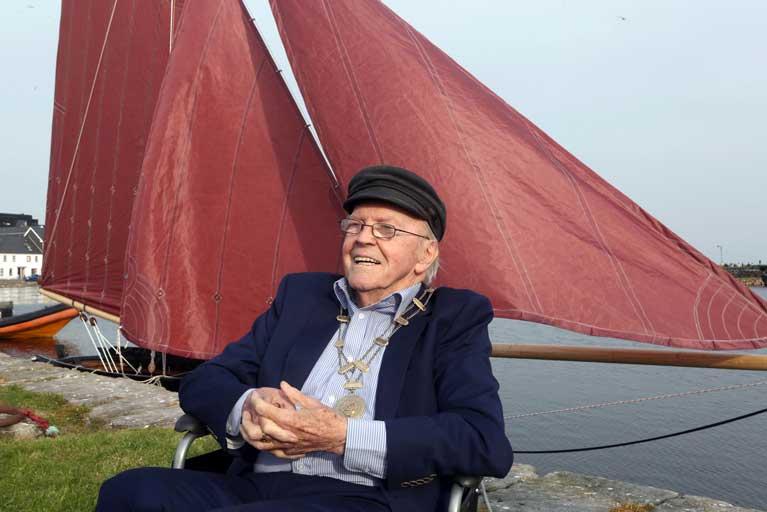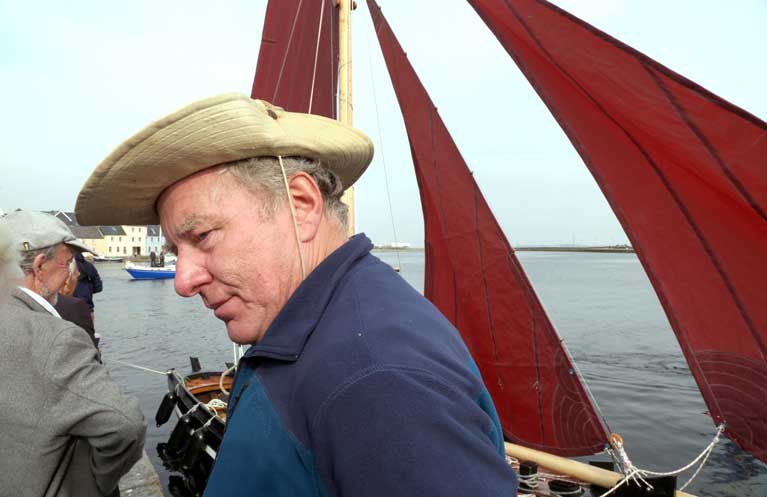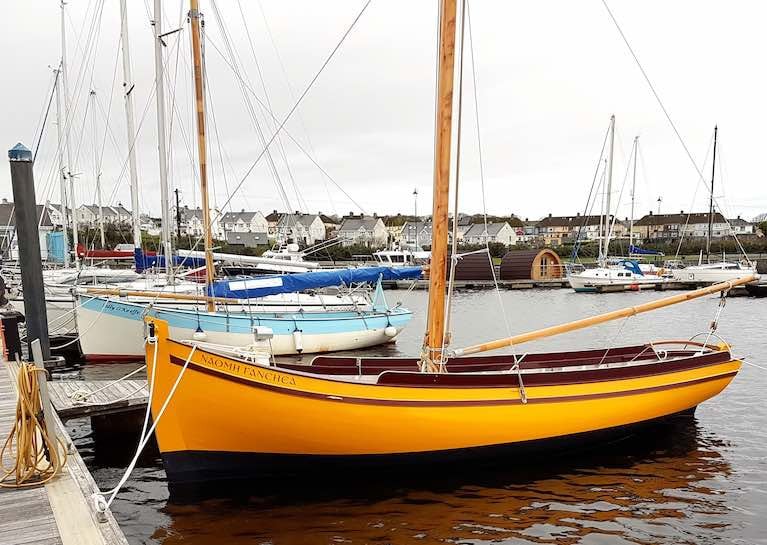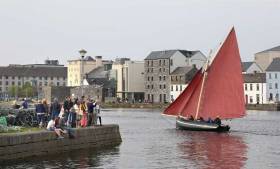Displaying items by tag: Gleoiteog
Tight Contest for Galway Hookers and Gleoiteogs at 44th Cruinniú na mBád in Kinvara
Tight competition marked the 44th annual Cruinniú na mBád festival in Kinvara, Co Galway at the weekend.
In spite of a dark and overcast day, the festival was a success on and off water, with An Norah taking the top price in the leath bháid class.
In the gleoiteoga móra class, the Ina “kept her winning streak”, according to Máire Ní Einniú who took photos at the event.
 An Norah Bheag, an Feichin and Báid Choil beag making their way to a start at the 44th annual Cruinniú na mBád festival in Kinvara, Co Galway Photo: Máire Ní Éinniú
An Norah Bheag, an Feichin and Báid Choil beag making their way to a start at the 44th annual Cruinniú na mBád festival in Kinvara, Co Galway Photo: Máire Ní Éinniú
The Ina is owned by Clann Uí Ghríofa and was built in 2019 in Sruthán, An Cheathrú Rua by Michael MacDonnacha. It is crewed by three generations of the Griffin family and friends.
 An Katherine, took second place in the Gleoiteoga beaga at the 44th annual Cruinniú na mBád festival in Kinvara, Co Galway Photo: Máire Ní Éinniú
An Katherine, took second place in the Gleoiteoga beaga at the 44th annual Cruinniú na mBád festival in Kinvara, Co Galway Photo: Máire Ní Éinniú
The Katherine was built in 2008 in Leitir Mealláin by Martin Mullins and is owned by Pádraig Barrett.
 An Stiofan closely behind the McHugh in breeze at the 44th annual Cruinniú na mBád festival in Kinvara, Co Galway Photo: Máire Ní Éinniú
An Stiofan closely behind the McHugh in breeze at the 44th annual Cruinniú na mBád festival in Kinvara, Co Galway Photo: Máire Ní Éinniú
Three boats had to restart in the gleoiteoga beaga class. However, two of the three, Norah Bheag and Feichín, managed to make their way back up to take second and third place respectively.
An Norah Bheag is owned by Coilín Ó hIarnáin and helmed by Coilín Óg. It was built in 1916 by Seán Ó Dómhnaill.
 An Ina heading to the finish line at the 44th annual Cruinniú na mBád festival in Kinvara, Co Galway Photo: Máire Ní Éinniú
An Ina heading to the finish line at the 44th annual Cruinniú na mBád festival in Kinvara, Co Galway Photo: Máire Ní Éinniú
Feichín was built in 2002 by Donal Greene and is owned and helmed by Michael Kelly.
The McHugh is now leading the season’s hooker racing series, with five points, meaning the next two races are vital, Ní Éinniú notes.
The McHugh is another century-old craft, having been built by Pádraig O’Casey in Mweenish in 1917. It is helmed by Donál Mac Dhonnacha and crew Seán Éinniú and Keith Ridge.
Sruthán Buí is a 17-year-old gleoiteog based in Lettermullen, south Connemara, which will embark on an unusual trip later this month.
Its owner Mairtín Óg MacDonnacha, his cousins Joe and Michael Barrett and several others will set off on May 19th - weather permitting - from Lettermullen for Galway city - via the lake and river Corrib, rather than the coast.
The aim is to raise funds for the Tigh Nan Dooley child education and development centre in An Cheathrú Rua, and for a local defibrillator campaign.
Padraig Ned O Chualain is assisting them with transporting the gleoiteog by truck from Leenane when they transfer from sea to Lough Corrib.
“My cousin Joe Barrett did it in a kayak in 2019, and we were talking about it, and said it hadn’t been done in a hooker before, “MacDonnacha said of the idea.
The first leg will be from Lettermullen to Rosroe pier outside the Killary, and from there on the second day, they will sail to Leenane.
 Mairtín Óg MacDonnacha on board the gleoiteog Sruthán Buí with his cousins Michael and Joe Barrett
Mairtín Óg MacDonnacha on board the gleoiteog Sruthán Buí with his cousins Michael and Joe Barrett
Sruthán Buí will then be taken by truck to Maam, where it will have to be derigged, and then rigged again on the lake for the next leg.
The challenge will take place over several weekends, to allow for crew work commitments.
“We hope to have it finished up on May 27th,”MacDonnacha said. “If the weather is promised bad, we might have to adjust those dates.”
MacDonnacha paid tribute to the support of Coilín Hernon and members of the Galway Hooker Sailing Club for their support.
The gleoiteog will stay on a mooring in the Claddagh basin in Galway until the crew are ready to sail it back by sea to Lettermullen.
Mairtín Og MacDonnacha and Michael Barrett spoke to Wavelengths at Tigh Mhicheál Jack, the Hooker Bar in Bealadangan, south Connemara, and you can listen below
Restored 96-Year-Old Gleoiteog Loveen to be Blessed at Claddagh Basin, Galway Today
Where else in the world would you hear yourself being addressed as Loveen but in Galway - and that's the name of a 96-year-old gleoiteog which is being blessed today (Oct 16) in the Claddagh Basin.
The historic vessel which was built by the Reaneys of Galway’s Spanish Arch was bought from the late Nicky Dolan in 2011 with the support of the former mayor and Labour councillor Niall MacNelis.
It was presented to the Port of Galway Sea Scouts, to help continue the culture and tradition of hooker sailing into the next generation
It has been restored, plank by plank, by expert boatbuilders Coilín Hernon, Ciarán Oliver and a large team from the Galway Hooker Sailing Association (GHSA).
The association, which has over 100 volunteers, began the project in 2019 and continued with careful restrictions through last year’s Covid-19 pandemic.
The Lovely Anne, a late 19th-century gleoiteog, already restored by the GHSA, will join a flotilla today to welcome the Loveen on to the water.
The Port of Galway Sea Scouts and the GHSA are hosting this afternoon’s celebration at Nimmo’s Pier on the Claddagh basin from 2 pm to 4 pm.
Free ticket admission can be obtained on this link here
Galway Gleoiteog "Loveen" Gets its Whiskey Plank
Galway's 96-year old gleoiteog Loveen has marked a key stage in its restoration with the nailing of its "whiskey plank".
At a "low key" ceremony, the final plank was secured and the occasion was marked with a "modest" round of whiskey.
The Loveen had been bought by Nicky Dolan shortly before his passing in 2011.
 Frankie Dolan, Station Officer with Galway Fire and Rescue Service, Frankie is a cousin of the late Nicky Dolan who was the last owner of The Loveen Photo: Joe O'Shaughnessy
Frankie Dolan, Station Officer with Galway Fire and Rescue Service, Frankie is a cousin of the late Nicky Dolan who was the last owner of The Loveen Photo: Joe O'Shaughnessy
It was presented to the Port of Galway Sea Scouts the following year.
 Daniel Concannon of Port of Galway Sea Scouts inspects the Loveen. Galway Hooker Sailing Club are restoring the Loveen on behalf of the Sea Scouts Photo: Joe O'Shaughnessy
Daniel Concannon of Port of Galway Sea Scouts inspects the Loveen. Galway Hooker Sailing Club are restoring the Loveen on behalf of the Sea Scouts Photo: Joe O'Shaughnessy
A restoration project began in 2019, which was spearheaded by Galway Hooker Sailing Club with the enthusiastic support of the sea scouts.
 Coilin Hernon with his sons Einde and Coilin Og at the Loveen at Galway Harbour. The Hernon family are boatbuilders and key members of keeping the tradition of Galway Hookers alive Photo: Joe O'Shaughnessy
Coilin Hernon with his sons Einde and Coilin Og at the Loveen at Galway Harbour. The Hernon family are boatbuilders and key members of keeping the tradition of Galway Hookers alive Photo: Joe O'Shaughnessy
Founder members of the club are the Oliver family of the Claddagh, and their aim is to continue to support the tradition of Galway hooker sailing, and the culture around it, into the next generation.
 A poster details of the Loveen project Photo: Joe O'Shaughnessy
A poster details of the Loveen project Photo: Joe O'Shaughnessy
 Ross Forde, Club Director, gives a helping hand to his son Jamie at hammering in a nail on the Loveen Photo: Joe O'Shaughnessy
Ross Forde, Club Director, gives a helping hand to his son Jamie at hammering in a nail on the Loveen Photo: Joe O'Shaughnessy
 Daniel Concannon of Port of Galway Sea Scouts hammers in a nail on the Loveen Photo: Joe O'Shaughnessy
Daniel Concannon of Port of Galway Sea Scouts hammers in a nail on the Loveen Photo: Joe O'Shaughnessy
 Tina Concannon, Club Secretary, hammers home a nail on the Loveen Photo: Joe O'Shaughnessy
Tina Concannon, Club Secretary, hammers home a nail on the Loveen Photo: Joe O'Shaughnessy
St Patrick’s festival is being marked with an illuminated gleoiteog in Galway’s Claddagh basin this week.
The gleoiteog Manuela has been decorated with lights by Bádóirí an Cladaig, the city association dedicated to training and restoration of the traditional craft.
The vessel was named in memory of Manuela Riedo, the Swiss student who was raped and murdered in Galway in October 2007
Bádóirí an Cladaig also illuminated several of its fleet of traditional vessels in the Claddagh basin over Christmas and new year, raising spirits during the pandemic.
Almost two years ago, the training organisation launched The Lovely Anne, a 137-year-old workboat built-in 1882 by boat-wright, Patrick Brannelly.
Brannelly also built An Tónaí and the Morning Star.
After being part of the local hooker fleet in the early 1900s, the vessel was sold over 46 years ago to Jim Parkinson, who fished it for many years.
Electric Power Adds a New Element to Kilrush-Built Traditional Galway Bay Gleoiteog
Steve Morris of Kilrush Boatyard and his lead boat-builder Dan Mill are busy these days, as their team have two further Dublin Bay 21s under construction for the Hal Sisk/Fionan de Barra project, and this week they launched the new "Gleoiteog with a difference" for a local couple who sought a traditional sailing boat with impeccable ecological credentials. Thus while they realised auxiliary power was a requirement, the clients insisted on an electric auxiliary unit, and this has been achieved with a Torqueedo turbine incorporated in the rudder, which suggests there's quite a bit of Antipodean savvy and ingenuity being applied to the boat-building scene down in West Clare.
 Steve Morris and Dan Mill are bringing Antipodean skill and ingenuity to the boat-building scene in West Clare. Photo: W M Nixon
Steve Morris and Dan Mill are bringing Antipodean skill and ingenuity to the boat-building scene in West Clare. Photo: W M Nixon
From ahead, the new boat looks like an interesting refinement to the traditional concept for a 23ft gleoiteog, in which the length is 23ft from the aft side of the stem to the transom, meaning that under other jurisdictions she'd be regarded as a 24-footer.
Thus as they have their own way of doing things in Galway Bay, we don't quite know what they'll make of What Steve Did Next. For although he took the lines off a classic gleoiteog belonging to a friend in The Claddagh in Galway City, he subsequently raised the topsides a bit and increased the beam before beginning construction for the Kilrush customers.
Be that as it may, when seen from ahead first while under construction, and then after she'd emerged newly-finished from the shed in recent days, there's no doubt that the true spirit of a curvaceous gleiteog had been achieved, made all the more impressive by gleaming topsides which have been painted in a glorious luminous colour for which "deep yellow" is scarcely appropriate.
 Although some modifications had been made to lines taken off a traditional gleoiteog, as the new boat took shape there was no doubting her true credentials. Photo: Steve Morris
Although some modifications had been made to lines taken off a traditional gleoiteog, as the new boat took shape there was no doubting her true credentials. Photo: Steve Morris
 The Naomh Fanchea achieves an elegant balance between traditional precepts and classic boat standards, but the view from ahead hides her surprise power-unit feature. Photo: Steve Morris
The Naomh Fanchea achieves an elegant balance between traditional precepts and classic boat standards, but the view from ahead hides her surprise power-unit feature. Photo: Steve Morris
 The Torqueedo power pod may be mounted in and on the lower trailing edge of the rudder, but it is located in such a way that the propeller is working in clear water for maximum thrust. Photo: Steve Morris
The Torqueedo power pod may be mounted in and on the lower trailing edge of the rudder, but it is located in such a way that the propeller is working in clear water for maximum thrust. Photo: Steve Morris
It's when you go round to the transom that the secret weapon is found, a 4kw Torqueedo pod mounted partially within the foot of the rudder with controls - and power from two Torqueedo lithium batteries in the boat – transmitted by a substantial cable from the transom into the rudderhead and then led down within the rudder itself to the power pod.
 The propeller installed, with the transmission cable socketed into the transom and the lower edge of the cheek of the rudder-head. Photo: Steve Morris
The propeller installed, with the transmission cable socketed into the transom and the lower edge of the cheek of the rudder-head. Photo: Steve Morris
 The view from astern reveals the increased beam and the way in which the rudder-mounted propellor is kept in clear water, while getting some protection from the fact that the foot of the rudder is fitted a few inches above the bottom of the keel.
The view from astern reveals the increased beam and the way in which the rudder-mounted propellor is kept in clear water, while getting some protection from the fact that the foot of the rudder is fitted a few inches above the bottom of the keel.
In due course, there'll be time to test Naomh Fanchea's performance with the first traditional sunrise sail round Scattery Island under the sails which have been made for her by Yannick Lemonnier of Quantum Sails in Galway, but with such a novel auxiliary motive unit, the immediate curiosity was about performance and range under power.
Torqueedo provides a sophisticated monitoring system which enables you to evaluate speed against range in real-time, which is very much a primary concern at the present developmental stage of battery power longevity. The news is that while Naomh Fanchea could clock 6.5 knots at full power, the available reserves were almost visibly depleting, but at 4.5 knots the unit was confident of 7.5 hours usage, suggesting a range of 33 miles.
 Smooth and silent – Naomh Fanchea under way in Kilrush Creek. Photo: Steve Morris
Smooth and silent – Naomh Fanchea under way in Kilrush Creek. Photo: Steve Morris
For those who think in terms of a range under engine of hundreds of miles, this may seem scarcely worthy of consideration. But for environmentally-conscious owners who live locally and will be using the boat for day sailing with the power unit only essential for accessing or exiting the lock at Kilrush and perhaps getting over the last few miles home on a calm evening, this is all that is required.
As for general handling and manoeuvring under power, this is described as excellent. And as Naomh Fanchea will be based in Kilrush Marina, access to shore power is immediate for connection to each lithium battery's own unit, which enables recharging from totally flat - something only rarely achieved - within 11 hours. In other words, you simply leave the boat plugged in overnight.
In addition, a separate 12-volt battery which is kept up to power by its own solar panel is used to service lights and instruments, the final addition to a very eco-friendly setup which sits well within the ambience of this particularly elegant example of the classic gleioteog.
 A sacred place – the Round Tower on Scattery Island off Kilrush in the Shannon Estuary. In keeping with local tradition, the new Naomh Fanchea will be christened by having her first sail at sunrise round Scattery.
A sacred place – the Round Tower on Scattery Island off Kilrush in the Shannon Estuary. In keeping with local tradition, the new Naomh Fanchea will be christened by having her first sail at sunrise round Scattery.
King of the Claddagh Michael Lynskey (88) and his community took to the Galway waterside at the weekend to welcome home a historic workboat which plied the Atlantic during two world wars writes Lorna Siggins
The 8m-long gleoiteog named Lovely Anne has been restored for sail training by Bádoirí an Cladaig.
Some ten nationalities were involved in refurbishing the gleoiteog, built by the well-known boatwright Patrick Brannelly in 1882 when German leader Otto von Bismarck and British prime minister William Gladstone were in power.
Master shipwright Coilín Hernon, who led the restoration with Ciarán Oliver, said Brannelly built a fleet of fine Galway hookers, with just three, including this gleoiteog, An Tonaí and the Morning Star surviving.
Brannelly died in an accident in his early 30s, when the Lovely Anne was being used to transport oysters between Bertraghboy Bay in Connemara and Rosmuc.
It passed through a number of owners in Connemara and on the Aran islands, was restored by Colm Breathnach at Camus, and was then acquired by Jim Parkinson of Killybegs, Co Donegal, who used it to fish salmon.
 The traditional Gleoiteog, the Lovely Anne, was re-launched at the Claddagh in Galway. Pictured on board the 137-year-old boat are Ross Forde, owner of the boat (left), and Pat Brannelly, both decendants of Patrick Brannelly who was the builder of the boat Photo: Joe O'Shaughnessy/Connacht Tribune
The traditional Gleoiteog, the Lovely Anne, was re-launched at the Claddagh in Galway. Pictured on board the 137-year-old boat are Ross Forde, owner of the boat (left), and Pat Brannelly, both decendants of Patrick Brannelly who was the builder of the boat Photo: Joe O'Shaughnessy/Connacht Tribune
Brannelly’s great great grandson, Ross Forde, who is involved with Bádoirí an Cladaig, traced the vessel to Killybegs and persuaded Parkinson to part with it. The refurbishment took five months, with Hernon and two of his sons cutting the sails and equipping the rig.
The Lovely Anne sailed over to Black Weir in Oranmore in the company of Mr Hernon’s gleoiteog, Nora Bheag, before returning to the Claddagh quay for its official welcome.
Mr Forde said that while over in Oranmore, he was told that the vessel had been named after an American woman named Anne, who was given a passage to a small island on it in rough conditions and described it as a “lovely boat”.
Bádoirí an Cladaig has endeavoured to extend its skills to non-sailing / fishing families through courses run with the Galway Roscommon Education and Training Board, and also held its inaugural festival in 2017.
Simon Wood, who had lived in Uganda for many years, and Harald Schlindwein from Germany are among the volunteers recruited by Badóirí an Cladaig, along with Liz Power, who is originally from Galway, and Niamh Moloughney, a Claddagh resident.
“I had been away from Galway for a number of years, and when I returned I wanted to get involved in something a bit bigger than me, “Ms Power explained.
 Michael Lynskey, King of the Claddagh, sits at Claddagh Quay during the re-launch of the Geloiteog, the Lovely Anne. Michael was the owner of the Galway Gleoiteog, Annie Photo: Joe O'Shaughnessy/Connacht Tribune
Michael Lynskey, King of the Claddagh, sits at Claddagh Quay during the re-launch of the Geloiteog, the Lovely Anne. Michael was the owner of the Galway Gleoiteog, Annie Photo: Joe O'Shaughnessy/Connacht Tribune
“We did a fair bit of sanding and a fair bit of watching Coilín Hernon doing his expert work,” Ms Moloughney laughed.
Relatives of both the boatbuilder and former owners of the vessel had attended the launch, including Mary Tipton, a relative of Brannelly, who flew from Cornwall, England.
“Not only is this an incredibly moving story of bringing our Galway heritage back to life, but we are extremely delighted to also announce that the Lovely Anne is now our dedicated training vessel,” Ciarán Oliver said. “We will be offering skills training classes for adults and children throughout 2019,” he added.
 Coilin Hernon at the re-launch of the Gleoiteog, the Lovely Anne, at Claddagh Quay in Galway. Coilin was one of the restorers of the 137-year-old boat. He and his sons Coilin Og and Einde also cut the sails for the Lovely Anne Photo: Joe O'Shaughnessy/Connacht Tribune
Coilin Hernon at the re-launch of the Gleoiteog, the Lovely Anne, at Claddagh Quay in Galway. Coilin was one of the restorers of the 137-year-old boat. He and his sons Coilin Og and Einde also cut the sails for the Lovely Anne Photo: Joe O'Shaughnessy/Connacht Tribune






























































